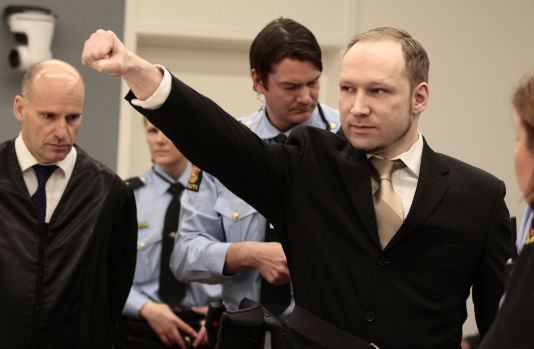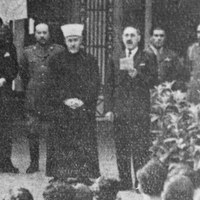![]()
Wed, April 25, 2012 | Middle East Forum | by Raymond Ibrahim
Originally published in Frontpage Magazine.

Anders Breivik gives a closed-fist salute as he arrives in the courtroom for the beginning of his trial in Oslo, Norway, April 2012.
Anders Breivik, who went on a shooting spree in Norway last year, killing some 70 people, recently confessed his inspiration: al-Qaeda, the jihadists par excellence of the modern world.
According to AFP, “The gunman behind the Norway massacres said he was inspired by al-Qaida as he took the stand Tuesday [4/17] at his trial… he described himself as a ‘militant nationalist’ and, using the pronoun ‘we’ to suggest he was part of a larger group, added: ‘We have drawn from al-Qaida and militant Islamists. You can see al-Qaida as the most successful militant group in the world.'”
Not only was he “inspired” by al-Qaeda, but his very tactics mirrored those of the jihadist organization. According to the AP, Breivik testified “that he had planned to capture and decapitate” the former Norwegian Prime Minister, with the plan “to film the beheading and post the video on the Internet,” adding that “he was inspired by al-Qaida’s use of decapitation,” which he described “as a very powerful psychological weapon.”
In a globalized world where Islam has the lion’s share of acts of terrorism — where nonstop images of jihadists killing and beheading people have metastasized in the media, and thus in the mind of the average person — discovering that al-Qaeda is Breivik’s source of inspiration is, of course, not surprising.
But there is a more profound point here: Breivik is not the first non-Muslim to be “inspired” by Muslim notions; the Crusaders, for example, lived in an atmosphere thoroughly permeated and influenced by Islamic jihad, so much so that the very idea of Christian “holy war” — the use of violence and conquest in the name of Christianity — finds its ideological origins in jihad.
Emmet Scott, for instance, author of the new book Mohammed and Charlemagne Revisited writes:
[I]n addition to some commentaries upon Aristotle, and a few scientific and technological concepts (which were not “Arab” inventions at all) Islam was to communicate to Europe a whole host of ideas and attitudes that were far from being enlightened. Most obviously, the concept of “holy war” [or jihad], which Europe adopted (admittedly somewhat reluctantly) in the eleventh century, was entirely an Islamic innovation (p. xx).
Earlier, historian Bernard Lewis wrote,
Even the Christian crusade, often compared with the Muslim jihad, was itself a delayed and limited response to the jihad and in part also an imitation…. [F]orgiveness for sins to those who fought in defence of the holy Church of God and the Christian religion and polity, and eternal life for those fighting the infidel: these ideas … clearly reflect the Muslim notion of jihad, and are precursors of the Western Christian Crusade.
For all that, Islamic ideologies did not pervert the foundations of Christianity. Lewis continues:
But unlike the jihad, it [the Crusade] was concerned primarily with the defense or reconquest of threatened or lost Christian territory.… The Muslim jihad, in contrast, was perceived as unlimited, as a religious obligation that would continue until all the world had either adopted the Muslim faith or submitted to Muslim rule.… The object of jihad is to bring the whole world under Islamic law.
The point here is that the earliest manifestations of the sort of terrorism initiated by Breivik are Islamic in origin. For instance, the medieval Hashashin — the archetypal terrorists who gave us the word “assassin” — were a Muslim sect that pioneered the use of fear, murder, and terror for political gain as early as the 11th century.
Even so, the media has inclined to focus on Breivik’s fascination with Christian historical groups like the Knights Templar — without bothering to explain exactly how a military order devoted to protecting Christian pilgrims inspired Breivik to murder innocent Norwegian children. As one historian put it, the original Knights Templar, a “very devout people,” would be “horrified” to be associated with Breivik.
Even more ironic, the Knights and Crusaders in general were frequently on the receiving end of the aforementioned Hashashin’s terror campaign; that is, far from being inspirations for terrorism, the Knights Templar bore the brunt of one of the earliest manifestations of Islamic terrorism. Even CNN’s Fareed Zakaria correctly opined that in Breivik’s distorted worldview, “the Knights Templar resembles nothing so much as al Qaeda.”
In short, whereas Breivik’s goals may have been anti-Islamic in nature, his actions, those things which we are rightly judged by — in this case, from ruthless terrorism to planned beheadings — were jihadist in essence.
Raymond Ibrahim is a Shillman Fellow at the David Horowitz Freedom Center and an Associate Fellow at the Middle East Forum.



 RSS
RSS










Latest Comments
Hello Mike, Thank you for your positive feedback to the article. I felt there wasn’t too much critical analysis of ...
Thanks for this considered and well constructed article. A follow up article on the manner in which the editorial contro...
THE CLUELESSNESS OF CLAIMING THAT OBAMA'S MIDDLE EAST POLICIES WERE A FAILURE CANNOT BE FURTHER FROM THE TRUTH, WHAT THE...
As long as Obama is the president of the usa do not trust the us government......
Thank you for an good read....